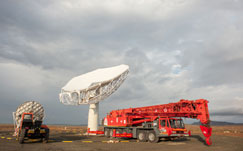Max Planck Institute invests in MeerKAT
4 December 2014
Germany's Max Planck Institute for Radio Astronomy (MPIfR) is investing R150-million in
the construction and installation of radio receivers on South Africa's MeerKAT radio
telescope, at the Square Kilometre Array (SKA).
Science and Technology Minister Naledi Pandor and the president of the Max Planck
Society (MPG), Martin Stratmann, made the announcement on 2 December.
The 64-dish MeerKAT, expected to be complete in 2017, will form part of the SKA, which
will be the largest radio telescope in the world. The R2-billion MeerKAT is a South
African-funded and designed telescope. Some 75% of the components are being sourced
locally. Once finished, it will be the most sensitive radio telescope of its kind in the
southern hemisphere.
Radio telescopes have a number of receivers, each of which focuses on a different part
of the radio wave spectrum.
The receivers to be funded by the institute would be primarily for
"research on pulsars,
[which are] rapidly spinning neutron stars which emit very regular radio pulses and can
be used as highly accurate clocks to test extreme physics", it said.
The receivers will be built by the institute and will operate in the S band of radio
frequencies. Two other sets of receivers, for the L band and UHF band of frequencies,
are being built in South Africa.
"We consider MeerKAT to be an important undertaking as it is not only a pre-eminent
astronomy project, but also a light-house project for science in Africa in general," said
Stratmann. "The MPG is very pleased to enable close collaboration between its scientists
and the South African community and looks forward to see MeerKAT's first glimpse of
the universe with the receivers of the MPIfR."
Pandor said the investment was an endorsement of the excellence of the MeerKAT and
the South African team that designed and was building it.
"This significant investment by a
leading global research organisation of prestigious
repute, home to several Nobel Prize winners, [is] an important vote of confidence, in
South African science in general and the MeerKAT specifically."
MeerKAT will be the most sensitive centimetre wave radio telescope in the world until
the SKA is built. It is expected to do transformational science on pulsars and other areas
of astronomy.
The MPIfR said its receiver project would not only grant its scientists access to a world-
class facility and its unique unrestricted view on our galaxy, but would also extend the
frequency range for all MeerKAT scientists and so boost MeerKAT's scientific potential
even further.
"Radio astronomy provides an independent view of the cosmos," it explained. "It allows
the study of objects and processes that are otherwise not accessible, and enables the
study of a wide range of questions in fundamental physics and astrophysics."
The discovery space was mostly
limited by the sensitivity of the radio telescopes, but
other factors like sky access, time and frequency resolution also played a role.
MeerKAT would even be more sensitive than the largest fully-steerable radio telescopes
in the northern hemisphere. In addition, it would provide a spatial resolution comparable
to an 8km diameter telescope, making its science potential enormous.
"The MeerKAT receiver project at our institute provides a receiving system that is finely
tuned to the science interests of Max Planck scientists," said Gundolf Wieching, head of
the electronics division at MPIfR, where the new receiver will be built.
In addition to providing the frontend, the complete project includes the design and the
construction of a state-of-the-art digital backend system which will turn MeerKAT into a
discovery machine for pulsars and other time-domain phenomena.
The receiver system will be designed and constructed by MPIfR in collaboration
with its
colleagues from the universities of Manchester and Oxford.
"The investment is an endorsement of the excellence of the MeerKAT and the South
African team which designed and is building it," said Bernie Fanaroff, the director of SKA
South Africa.
SAinfo reporter
 Standing 19.5 metres tall and weighing 42 tons: the first antenna of South Africa's 64-dish MeerKAT radio telescope at the Square Kilometre Array South Africa site outside Carnarvon in the Northern Cape (Photo: SKA South Africa)
Standing 19.5 metres tall and weighing 42 tons: the first antenna of South Africa's 64-dish MeerKAT radio telescope at the Square Kilometre Array South Africa site outside Carnarvon in the Northern Cape (Photo: SKA South Africa)




